Report on Corporations, Business Structures: LAWS20059, Term 1, 2019
VerifiedAdded on 2023/01/23
|7
|2245
|59
Report
AI Summary
This report provides a comprehensive analysis of various business structures available in Australia, including sole traders, partnerships, and proprietary companies. It examines the key characteristics, advantages, and disadvantages of each structure, focusing on aspects such as liability, registration costs, and legal compliance. The report delves into the liabilities of partners and directors in contractual relationships, highlighting the differences between partnerships and companies, including the concept of limited liability and the lifting of the corporate veil. Furthermore, it explores the duties of partners and directors, both under common law and statute, emphasizing fiduciary duties and statutory obligations, and the consequences of breaching these duties. The analysis includes relevant case law and legislation, offering a detailed comparison of the responsibilities and legal frameworks governing these business structures.
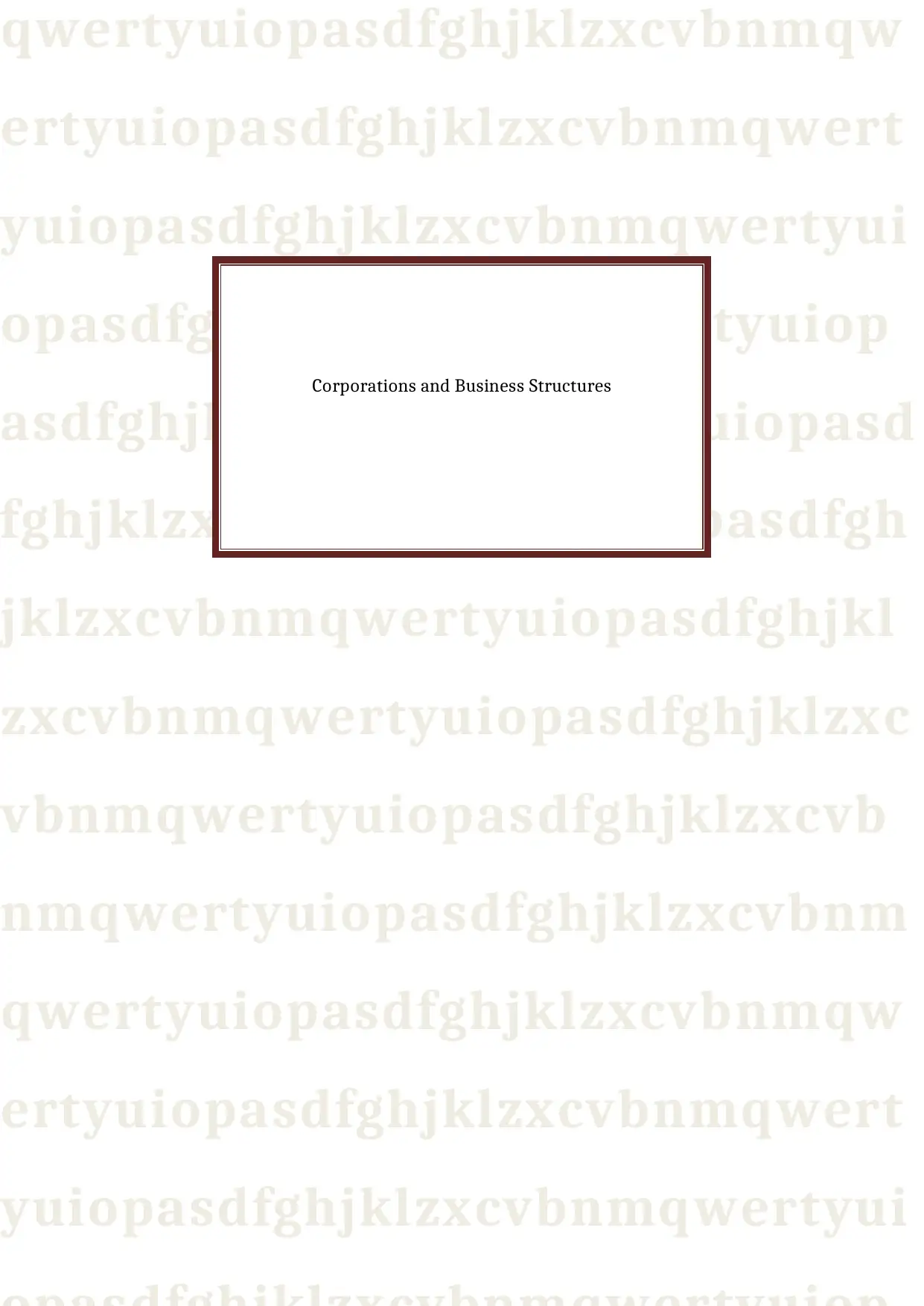
qwertyuiopasdfghjklzxcvbnmqw
ertyuiopasdfghjklzxcvbnmqwert
yuiopasdfghjklzxcvbnmqwertyui
opasdfghjklzxcvbnmqwertyuiop
asdfghjklzxcvbnmqwertyuiopasd
fghjklzxcvbnmqwertyuiopasdfgh
jklzxcvbnmqwertyuiopasdfghjkl
zxcvbnmqwertyuiopasdfghjklzxc
vbnmqwertyuiopasdfghjklzxcvb
nmqwertyuiopasdfghjklzxcvbnm
qwertyuiopasdfghjklzxcvbnmqw
ertyuiopasdfghjklzxcvbnmqwert
yuiopasdfghjklzxcvbnmqwertyui
Corporations and Business Structures
ertyuiopasdfghjklzxcvbnmqwert
yuiopasdfghjklzxcvbnmqwertyui
opasdfghjklzxcvbnmqwertyuiop
asdfghjklzxcvbnmqwertyuiopasd
fghjklzxcvbnmqwertyuiopasdfgh
jklzxcvbnmqwertyuiopasdfghjkl
zxcvbnmqwertyuiopasdfghjklzxc
vbnmqwertyuiopasdfghjklzxcvb
nmqwertyuiopasdfghjklzxcvbnm
qwertyuiopasdfghjklzxcvbnmqw
ertyuiopasdfghjklzxcvbnmqwert
yuiopasdfghjklzxcvbnmqwertyui
Corporations and Business Structures
Paraphrase This Document
Need a fresh take? Get an instant paraphrase of this document with our AI Paraphraser
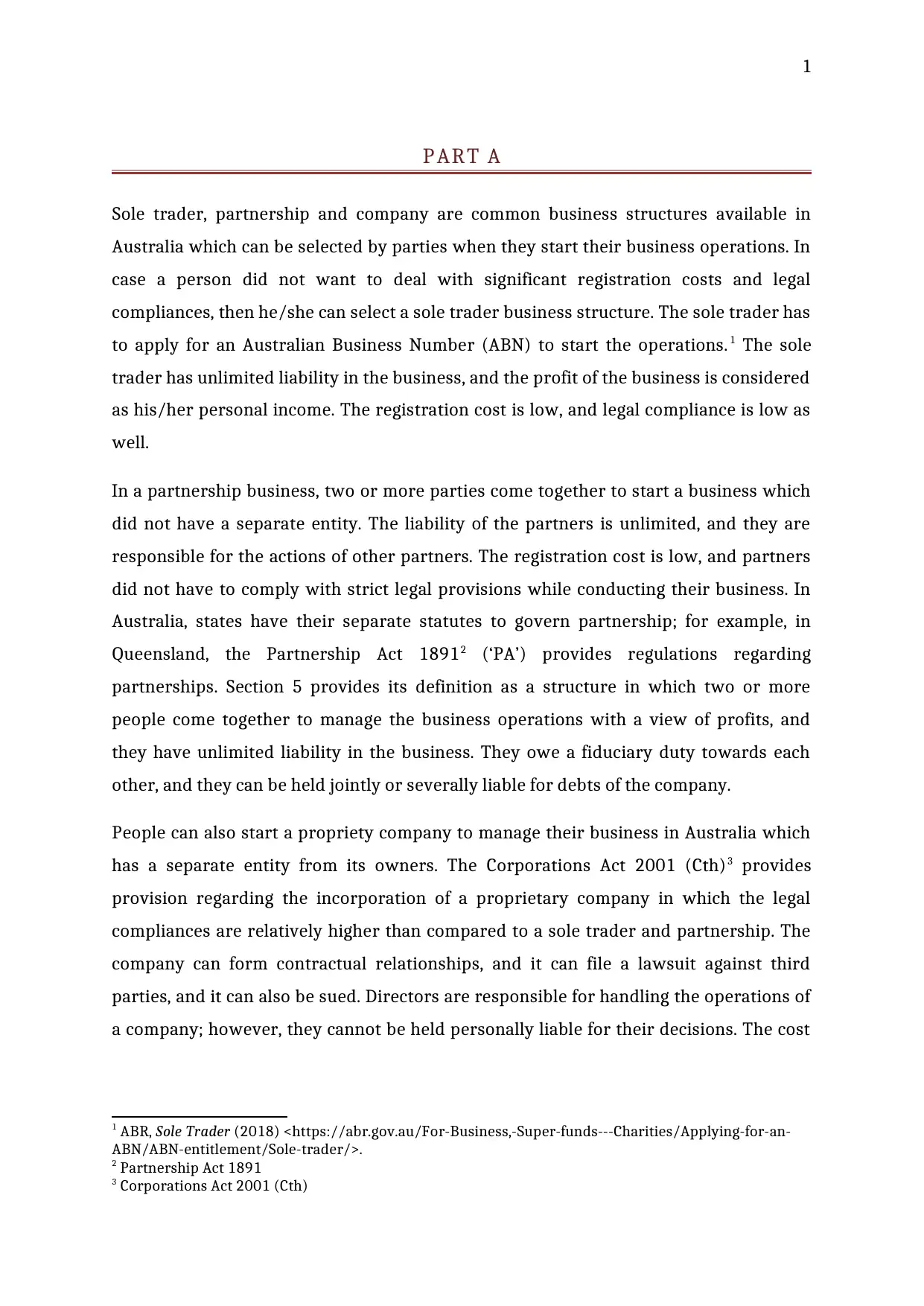
1
PART A
Sole trader, partnership and company are common business structures available in
Australia which can be selected by parties when they start their business operations. In
case a person did not want to deal with significant registration costs and legal
compliances, then he/she can select a sole trader business structure. The sole trader has
to apply for an Australian Business Number (ABN) to start the operations.1 The sole
trader has unlimited liability in the business, and the profit of the business is considered
as his/her personal income. The registration cost is low, and legal compliance is low as
well.
In a partnership business, two or more parties come together to start a business which
did not have a separate entity. The liability of the partners is unlimited, and they are
responsible for the actions of other partners. The registration cost is low, and partners
did not have to comply with strict legal provisions while conducting their business. In
Australia, states have their separate statutes to govern partnership; for example, in
Queensland, the Partnership Act 18912 (‘PA’) provides regulations regarding
partnerships. Section 5 provides its definition as a structure in which two or more
people come together to manage the business operations with a view of profits, and
they have unlimited liability in the business. They owe a fiduciary duty towards each
other, and they can be held jointly or severally liable for debts of the company.
People can also start a propriety company to manage their business in Australia which
has a separate entity from its owners. The Corporations Act 2001 (Cth)3 provides
provision regarding the incorporation of a proprietary company in which the legal
compliances are relatively higher than compared to a sole trader and partnership. The
company can form contractual relationships, and it can file a lawsuit against third
parties, and it can also be sued. Directors are responsible for handling the operations of
a company; however, they cannot be held personally liable for their decisions. The cost
1 ABR, Sole Trader (2018) <https://abr.gov.au/For-Business,-Super-funds---Charities/Applying-for-an-
ABN/ABN-entitlement/Sole-trader/>.
2 Partnership Act 1891
3 Corporations Act 2001 (Cth)
PART A
Sole trader, partnership and company are common business structures available in
Australia which can be selected by parties when they start their business operations. In
case a person did not want to deal with significant registration costs and legal
compliances, then he/she can select a sole trader business structure. The sole trader has
to apply for an Australian Business Number (ABN) to start the operations.1 The sole
trader has unlimited liability in the business, and the profit of the business is considered
as his/her personal income. The registration cost is low, and legal compliance is low as
well.
In a partnership business, two or more parties come together to start a business which
did not have a separate entity. The liability of the partners is unlimited, and they are
responsible for the actions of other partners. The registration cost is low, and partners
did not have to comply with strict legal provisions while conducting their business. In
Australia, states have their separate statutes to govern partnership; for example, in
Queensland, the Partnership Act 18912 (‘PA’) provides regulations regarding
partnerships. Section 5 provides its definition as a structure in which two or more
people come together to manage the business operations with a view of profits, and
they have unlimited liability in the business. They owe a fiduciary duty towards each
other, and they can be held jointly or severally liable for debts of the company.
People can also start a propriety company to manage their business in Australia which
has a separate entity from its owners. The Corporations Act 2001 (Cth)3 provides
provision regarding the incorporation of a proprietary company in which the legal
compliances are relatively higher than compared to a sole trader and partnership. The
company can form contractual relationships, and it can file a lawsuit against third
parties, and it can also be sued. Directors are responsible for handling the operations of
a company; however, they cannot be held personally liable for their decisions. The cost
1 ABR, Sole Trader (2018) <https://abr.gov.au/For-Business,-Super-funds---Charities/Applying-for-an-
ABN/ABN-entitlement/Sole-trader/>.
2 Partnership Act 1891
3 Corporations Act 2001 (Cth)
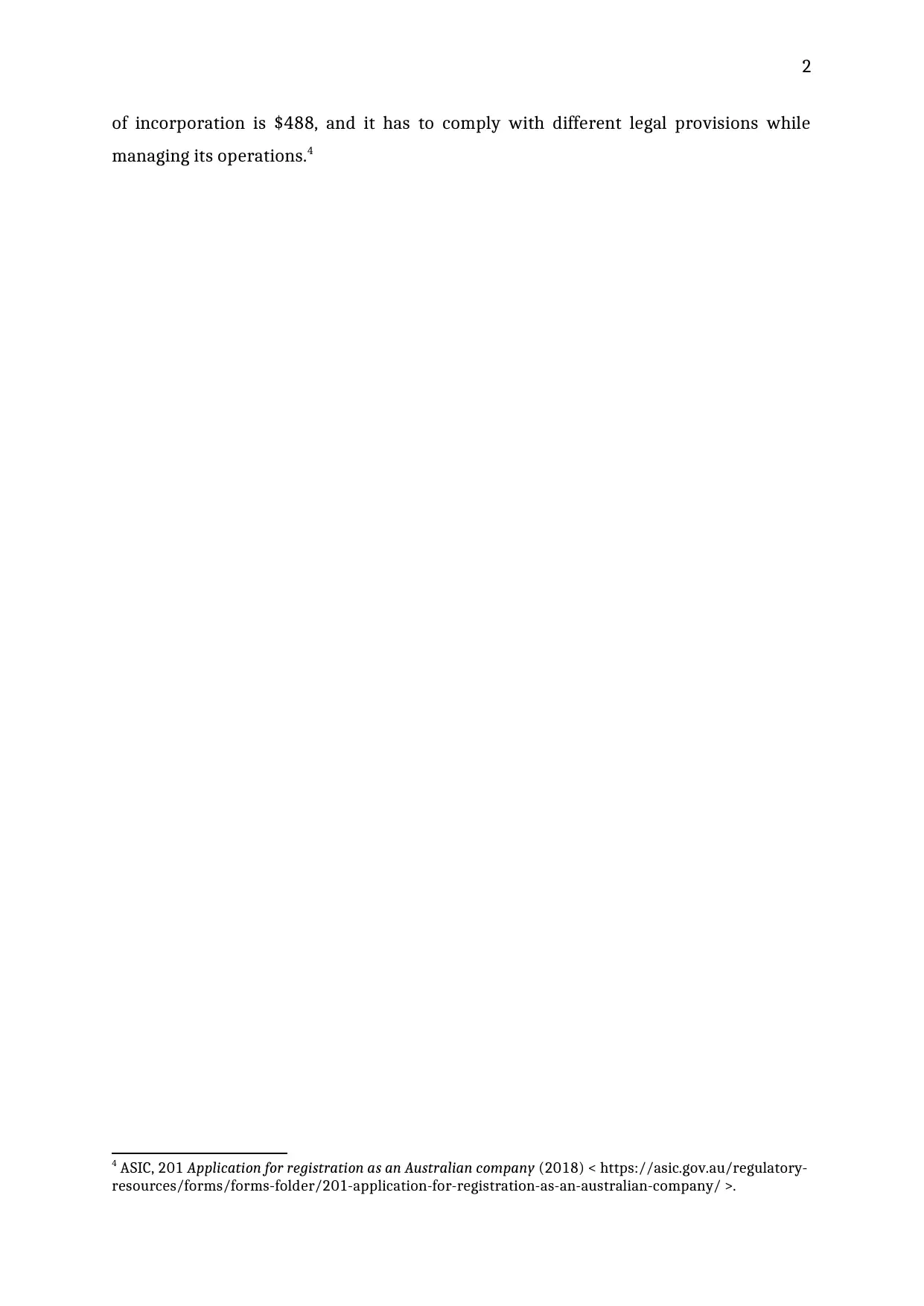
2
of incorporation is $488, and it has to comply with different legal provisions while
managing its operations.4
4 ASIC, 201 Application for registration as an Australian company (2018) < https://asic.gov.au/regulatory-
resources/forms/forms-folder/201-application-for-registration-as-an-australian-company/ >.
of incorporation is $488, and it has to comply with different legal provisions while
managing its operations.4
4 ASIC, 201 Application for registration as an Australian company (2018) < https://asic.gov.au/regulatory-
resources/forms/forms-folder/201-application-for-registration-as-an-australian-company/ >.
⊘ This is a preview!⊘
Do you want full access?
Subscribe today to unlock all pages.

Trusted by 1+ million students worldwide
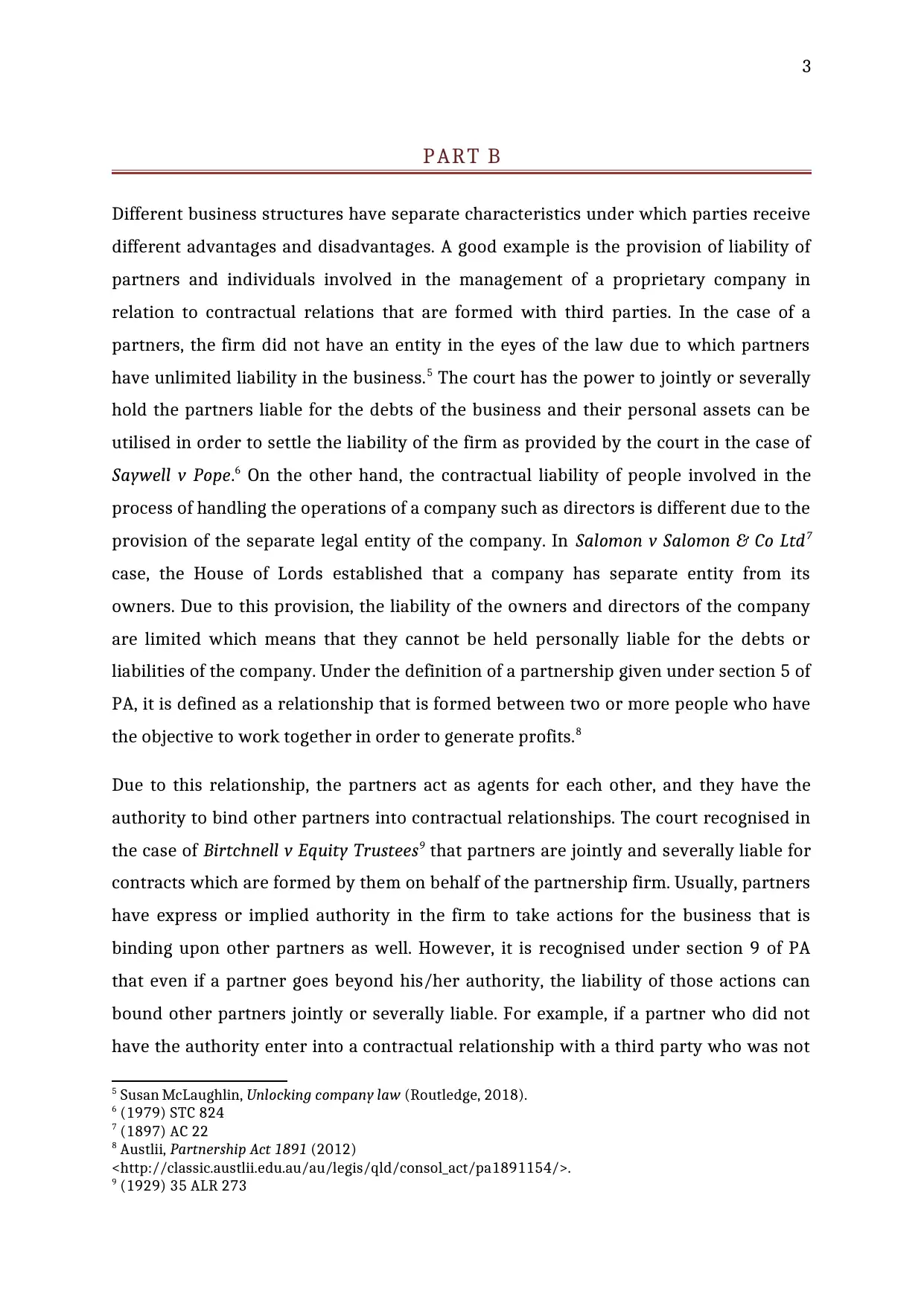
3
PART B
Different business structures have separate characteristics under which parties receive
different advantages and disadvantages. A good example is the provision of liability of
partners and individuals involved in the management of a proprietary company in
relation to contractual relations that are formed with third parties. In the case of a
partners, the firm did not have an entity in the eyes of the law due to which partners
have unlimited liability in the business.5 The court has the power to jointly or severally
hold the partners liable for the debts of the business and their personal assets can be
utilised in order to settle the liability of the firm as provided by the court in the case of
Saywell v Pope.6 On the other hand, the contractual liability of people involved in the
process of handling the operations of a company such as directors is different due to the
provision of the separate legal entity of the company. In Salomon v Salomon & Co Ltd7
case, the House of Lords established that a company has separate entity from its
owners. Due to this provision, the liability of the owners and directors of the company
are limited which means that they cannot be held personally liable for the debts or
liabilities of the company. Under the definition of a partnership given under section 5 of
PA, it is defined as a relationship that is formed between two or more people who have
the objective to work together in order to generate profits.8
Due to this relationship, the partners act as agents for each other, and they have the
authority to bind other partners into contractual relationships. The court recognised in
the case of Birtchnell v Equity Trustees9 that partners are jointly and severally liable for
contracts which are formed by them on behalf of the partnership firm. Usually, partners
have express or implied authority in the firm to take actions for the business that is
binding upon other partners as well. However, it is recognised under section 9 of PA
that even if a partner goes beyond his/her authority, the liability of those actions can
bound other partners jointly or severally liable. For example, if a partner who did not
have the authority enter into a contractual relationship with a third party who was not
5 Susan McLaughlin, Unlocking company law (Routledge, 2018).
6 (1979) STC 824
7 (1897) AC 22
8 Austlii, Partnership Act 1891 (2012)
<http://classic.austlii.edu.au/au/legis/qld/consol_act/pa1891154/>.
9 (1929) 35 ALR 273
PART B
Different business structures have separate characteristics under which parties receive
different advantages and disadvantages. A good example is the provision of liability of
partners and individuals involved in the management of a proprietary company in
relation to contractual relations that are formed with third parties. In the case of a
partners, the firm did not have an entity in the eyes of the law due to which partners
have unlimited liability in the business.5 The court has the power to jointly or severally
hold the partners liable for the debts of the business and their personal assets can be
utilised in order to settle the liability of the firm as provided by the court in the case of
Saywell v Pope.6 On the other hand, the contractual liability of people involved in the
process of handling the operations of a company such as directors is different due to the
provision of the separate legal entity of the company. In Salomon v Salomon & Co Ltd7
case, the House of Lords established that a company has separate entity from its
owners. Due to this provision, the liability of the owners and directors of the company
are limited which means that they cannot be held personally liable for the debts or
liabilities of the company. Under the definition of a partnership given under section 5 of
PA, it is defined as a relationship that is formed between two or more people who have
the objective to work together in order to generate profits.8
Due to this relationship, the partners act as agents for each other, and they have the
authority to bind other partners into contractual relationships. The court recognised in
the case of Birtchnell v Equity Trustees9 that partners are jointly and severally liable for
contracts which are formed by them on behalf of the partnership firm. Usually, partners
have express or implied authority in the firm to take actions for the business that is
binding upon other partners as well. However, it is recognised under section 9 of PA
that even if a partner goes beyond his/her authority, the liability of those actions can
bound other partners jointly or severally liable. For example, if a partner who did not
have the authority enter into a contractual relationship with a third party who was not
5 Susan McLaughlin, Unlocking company law (Routledge, 2018).
6 (1979) STC 824
7 (1897) AC 22
8 Austlii, Partnership Act 1891 (2012)
<http://classic.austlii.edu.au/au/legis/qld/consol_act/pa1891154/>.
9 (1929) 35 ALR 273
Paraphrase This Document
Need a fresh take? Get an instant paraphrase of this document with our AI Paraphraser
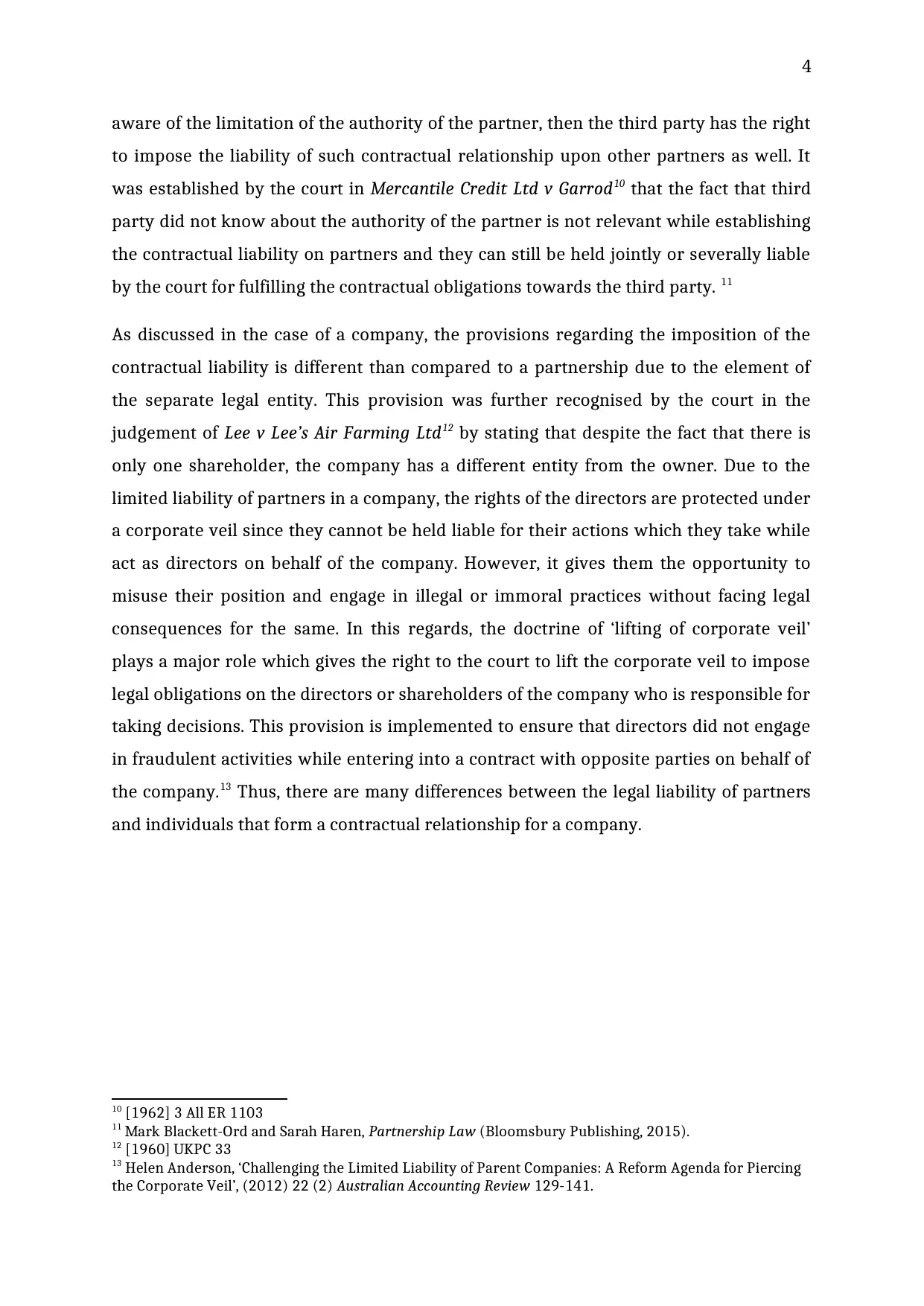
4
aware of the limitation of the authority of the partner, then the third party has the right
to impose the liability of such contractual relationship upon other partners as well. It
was established by the court in Mercantile Credit Ltd v Garrod10 that the fact that third
party did not know about the authority of the partner is not relevant while establishing
the contractual liability on partners and they can still be held jointly or severally liable
by the court for fulfilling the contractual obligations towards the third party. 11
As discussed in the case of a company, the provisions regarding the imposition of the
contractual liability is different than compared to a partnership due to the element of
the separate legal entity. This provision was further recognised by the court in the
judgement of Lee v Lee’s Air Farming Ltd12 by stating that despite the fact that there is
only one shareholder, the company has a different entity from the owner. Due to the
limited liability of partners in a company, the rights of the directors are protected under
a corporate veil since they cannot be held liable for their actions which they take while
act as directors on behalf of the company. However, it gives them the opportunity to
misuse their position and engage in illegal or immoral practices without facing legal
consequences for the same. In this regards, the doctrine of ‘lifting of corporate veil’
plays a major role which gives the right to the court to lift the corporate veil to impose
legal obligations on the directors or shareholders of the company who is responsible for
taking decisions. This provision is implemented to ensure that directors did not engage
in fraudulent activities while entering into a contract with opposite parties on behalf of
the company.13 Thus, there are many differences between the legal liability of partners
and individuals that form a contractual relationship for a company.
10 [1962] 3 All ER 1103
11 Mark Blackett-Ord and Sarah Haren, Partnership Law (Bloomsbury Publishing, 2015).
12 [1960] UKPC 33
13 Helen Anderson, ‘Challenging the Limited Liability of Parent Companies: A Reform Agenda for Piercing
the Corporate Veil’, (2012) 22 (2) Australian Accounting Review 129-141.
aware of the limitation of the authority of the partner, then the third party has the right
to impose the liability of such contractual relationship upon other partners as well. It
was established by the court in Mercantile Credit Ltd v Garrod10 that the fact that third
party did not know about the authority of the partner is not relevant while establishing
the contractual liability on partners and they can still be held jointly or severally liable
by the court for fulfilling the contractual obligations towards the third party. 11
As discussed in the case of a company, the provisions regarding the imposition of the
contractual liability is different than compared to a partnership due to the element of
the separate legal entity. This provision was further recognised by the court in the
judgement of Lee v Lee’s Air Farming Ltd12 by stating that despite the fact that there is
only one shareholder, the company has a different entity from the owner. Due to the
limited liability of partners in a company, the rights of the directors are protected under
a corporate veil since they cannot be held liable for their actions which they take while
act as directors on behalf of the company. However, it gives them the opportunity to
misuse their position and engage in illegal or immoral practices without facing legal
consequences for the same. In this regards, the doctrine of ‘lifting of corporate veil’
plays a major role which gives the right to the court to lift the corporate veil to impose
legal obligations on the directors or shareholders of the company who is responsible for
taking decisions. This provision is implemented to ensure that directors did not engage
in fraudulent activities while entering into a contract with opposite parties on behalf of
the company.13 Thus, there are many differences between the legal liability of partners
and individuals that form a contractual relationship for a company.
10 [1962] 3 All ER 1103
11 Mark Blackett-Ord and Sarah Haren, Partnership Law (Bloomsbury Publishing, 2015).
12 [1960] UKPC 33
13 Helen Anderson, ‘Challenging the Limited Liability of Parent Companies: A Reform Agenda for Piercing
the Corporate Veil’, (2012) 22 (2) Australian Accounting Review 129-141.
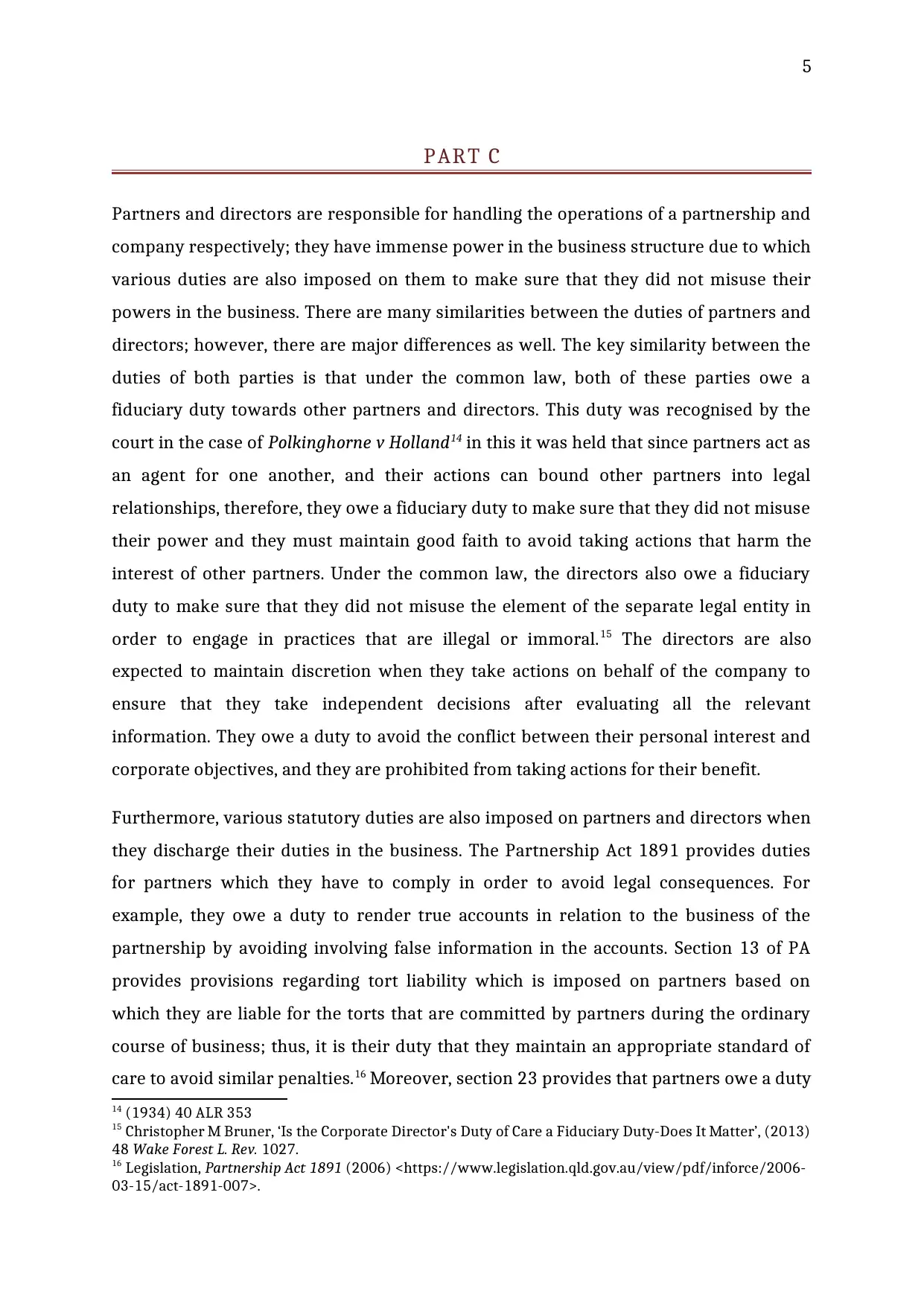
5
PART C
Partners and directors are responsible for handling the operations of a partnership and
company respectively; they have immense power in the business structure due to which
various duties are also imposed on them to make sure that they did not misuse their
powers in the business. There are many similarities between the duties of partners and
directors; however, there are major differences as well. The key similarity between the
duties of both parties is that under the common law, both of these parties owe a
fiduciary duty towards other partners and directors. This duty was recognised by the
court in the case of Polkinghorne v Holland14 in this it was held that since partners act as
an agent for one another, and their actions can bound other partners into legal
relationships, therefore, they owe a fiduciary duty to make sure that they did not misuse
their power and they must maintain good faith to avoid taking actions that harm the
interest of other partners. Under the common law, the directors also owe a fiduciary
duty to make sure that they did not misuse the element of the separate legal entity in
order to engage in practices that are illegal or immoral.15 The directors are also
expected to maintain discretion when they take actions on behalf of the company to
ensure that they take independent decisions after evaluating all the relevant
information. They owe a duty to avoid the conflict between their personal interest and
corporate objectives, and they are prohibited from taking actions for their benefit.
Furthermore, various statutory duties are also imposed on partners and directors when
they discharge their duties in the business. The Partnership Act 1891 provides duties
for partners which they have to comply in order to avoid legal consequences. For
example, they owe a duty to render true accounts in relation to the business of the
partnership by avoiding involving false information in the accounts. Section 13 of PA
provides provisions regarding tort liability which is imposed on partners based on
which they are liable for the torts that are committed by partners during the ordinary
course of business; thus, it is their duty that they maintain an appropriate standard of
care to avoid similar penalties.16 Moreover, section 23 provides that partners owe a duty
14 (1934) 40 ALR 353
15 Christopher M Bruner, ‘Is the Corporate Director's Duty of Care a Fiduciary Duty-Does It Matter’, (2013)
48 Wake Forest L. Rev. 1027.
16 Legislation, Partnership Act 1891 (2006) <https://www.legislation.qld.gov.au/view/pdf/inforce/2006-
03-15/act-1891-007>.
PART C
Partners and directors are responsible for handling the operations of a partnership and
company respectively; they have immense power in the business structure due to which
various duties are also imposed on them to make sure that they did not misuse their
powers in the business. There are many similarities between the duties of partners and
directors; however, there are major differences as well. The key similarity between the
duties of both parties is that under the common law, both of these parties owe a
fiduciary duty towards other partners and directors. This duty was recognised by the
court in the case of Polkinghorne v Holland14 in this it was held that since partners act as
an agent for one another, and their actions can bound other partners into legal
relationships, therefore, they owe a fiduciary duty to make sure that they did not misuse
their power and they must maintain good faith to avoid taking actions that harm the
interest of other partners. Under the common law, the directors also owe a fiduciary
duty to make sure that they did not misuse the element of the separate legal entity in
order to engage in practices that are illegal or immoral.15 The directors are also
expected to maintain discretion when they take actions on behalf of the company to
ensure that they take independent decisions after evaluating all the relevant
information. They owe a duty to avoid the conflict between their personal interest and
corporate objectives, and they are prohibited from taking actions for their benefit.
Furthermore, various statutory duties are also imposed on partners and directors when
they discharge their duties in the business. The Partnership Act 1891 provides duties
for partners which they have to comply in order to avoid legal consequences. For
example, they owe a duty to render true accounts in relation to the business of the
partnership by avoiding involving false information in the accounts. Section 13 of PA
provides provisions regarding tort liability which is imposed on partners based on
which they are liable for the torts that are committed by partners during the ordinary
course of business; thus, it is their duty that they maintain an appropriate standard of
care to avoid similar penalties.16 Moreover, section 23 provides that partners owe a duty
14 (1934) 40 ALR 353
15 Christopher M Bruner, ‘Is the Corporate Director's Duty of Care a Fiduciary Duty-Does It Matter’, (2013)
48 Wake Forest L. Rev. 1027.
16 Legislation, Partnership Act 1891 (2006) <https://www.legislation.qld.gov.au/view/pdf/inforce/2006-
03-15/act-1891-007>.
⊘ This is a preview!⊘
Do you want full access?
Subscribe today to unlock all pages.

Trusted by 1+ million students worldwide
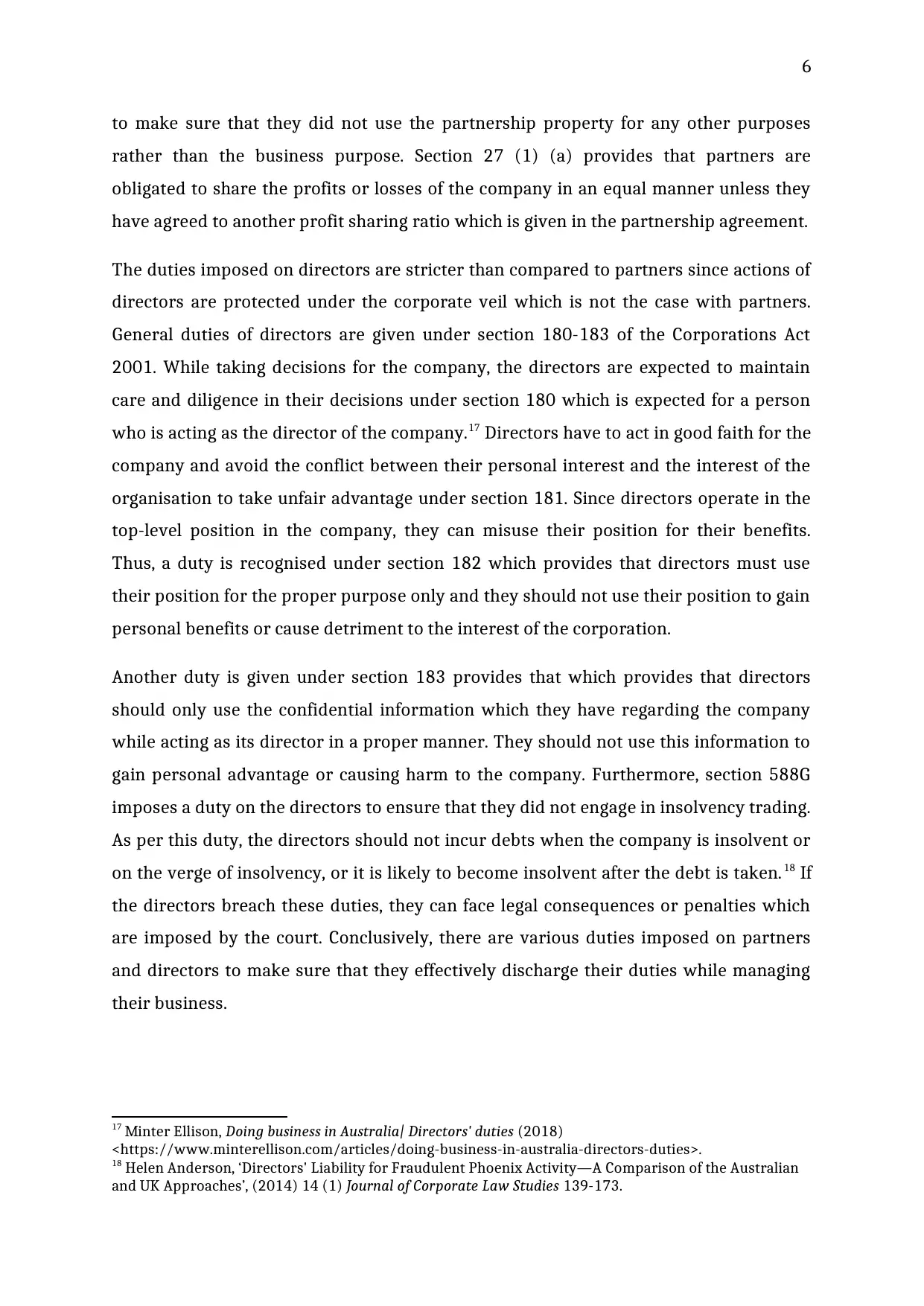
6
to make sure that they did not use the partnership property for any other purposes
rather than the business purpose. Section 27 (1) (a) provides that partners are
obligated to share the profits or losses of the company in an equal manner unless they
have agreed to another profit sharing ratio which is given in the partnership agreement.
The duties imposed on directors are stricter than compared to partners since actions of
directors are protected under the corporate veil which is not the case with partners.
General duties of directors are given under section 180-183 of the Corporations Act
2001. While taking decisions for the company, the directors are expected to maintain
care and diligence in their decisions under section 180 which is expected for a person
who is acting as the director of the company.17 Directors have to act in good faith for the
company and avoid the conflict between their personal interest and the interest of the
organisation to take unfair advantage under section 181. Since directors operate in the
top-level position in the company, they can misuse their position for their benefits.
Thus, a duty is recognised under section 182 which provides that directors must use
their position for the proper purpose only and they should not use their position to gain
personal benefits or cause detriment to the interest of the corporation.
Another duty is given under section 183 provides that which provides that directors
should only use the confidential information which they have regarding the company
while acting as its director in a proper manner. They should not use this information to
gain personal advantage or causing harm to the company. Furthermore, section 588G
imposes a duty on the directors to ensure that they did not engage in insolvency trading.
As per this duty, the directors should not incur debts when the company is insolvent or
on the verge of insolvency, or it is likely to become insolvent after the debt is taken.18 If
the directors breach these duties, they can face legal consequences or penalties which
are imposed by the court. Conclusively, there are various duties imposed on partners
and directors to make sure that they effectively discharge their duties while managing
their business.
17 Minter Ellison, Doing business in Australia| Directors' duties (2018)
<https://www.minterellison.com/articles/doing-business-in-australia-directors-duties>.
18 Helen Anderson, ‘Directors' Liability for Fraudulent Phoenix Activity—A Comparison of the Australian
and UK Approaches’, (2014) 14 (1) Journal of Corporate Law Studies 139-173.
to make sure that they did not use the partnership property for any other purposes
rather than the business purpose. Section 27 (1) (a) provides that partners are
obligated to share the profits or losses of the company in an equal manner unless they
have agreed to another profit sharing ratio which is given in the partnership agreement.
The duties imposed on directors are stricter than compared to partners since actions of
directors are protected under the corporate veil which is not the case with partners.
General duties of directors are given under section 180-183 of the Corporations Act
2001. While taking decisions for the company, the directors are expected to maintain
care and diligence in their decisions under section 180 which is expected for a person
who is acting as the director of the company.17 Directors have to act in good faith for the
company and avoid the conflict between their personal interest and the interest of the
organisation to take unfair advantage under section 181. Since directors operate in the
top-level position in the company, they can misuse their position for their benefits.
Thus, a duty is recognised under section 182 which provides that directors must use
their position for the proper purpose only and they should not use their position to gain
personal benefits or cause detriment to the interest of the corporation.
Another duty is given under section 183 provides that which provides that directors
should only use the confidential information which they have regarding the company
while acting as its director in a proper manner. They should not use this information to
gain personal advantage or causing harm to the company. Furthermore, section 588G
imposes a duty on the directors to ensure that they did not engage in insolvency trading.
As per this duty, the directors should not incur debts when the company is insolvent or
on the verge of insolvency, or it is likely to become insolvent after the debt is taken.18 If
the directors breach these duties, they can face legal consequences or penalties which
are imposed by the court. Conclusively, there are various duties imposed on partners
and directors to make sure that they effectively discharge their duties while managing
their business.
17 Minter Ellison, Doing business in Australia| Directors' duties (2018)
<https://www.minterellison.com/articles/doing-business-in-australia-directors-duties>.
18 Helen Anderson, ‘Directors' Liability for Fraudulent Phoenix Activity—A Comparison of the Australian
and UK Approaches’, (2014) 14 (1) Journal of Corporate Law Studies 139-173.
1 out of 7
Related Documents
Your All-in-One AI-Powered Toolkit for Academic Success.
+13062052269
info@desklib.com
Available 24*7 on WhatsApp / Email
![[object Object]](/_next/static/media/star-bottom.7253800d.svg)
Unlock your academic potential
Copyright © 2020–2025 A2Z Services. All Rights Reserved. Developed and managed by ZUCOL.




